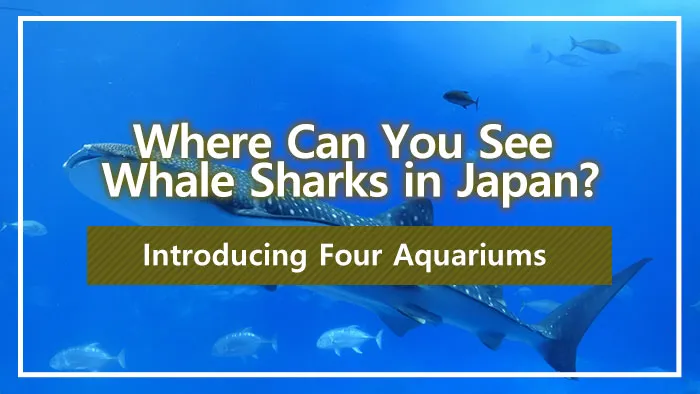If you’re looking for a “special experience” during your Japan trip, why not visit a whale shark? Known as the world’s largest fish species, whale sharks captivate many people with their size and graceful swimming. They can only be seen at a limited number of aquariums in Japan.
This article introduces four aquariums across Japan where you can encounter whale sharks. We’ll also explain access information and highlights to help you during your Japan trip.
1. Where can you see whale sharks?
The whale shark, the world’s largest fish species, is a popular marine creature that fascinates many people with its impressive appearance and gentle nature. In Japan, whale sharks are kept at only four aquariums, where you can enjoy their impressive presence up close at each facility.
- Notojima Aquarium (Ishikawa Prefecture)
- Osaka Aquarium Kaiyukan (Osaka Prefecture)
- Io World Kagoshima Aquarium (Kagoshima)
- Okinawa Churaumi Aquarium (Okinawa Prefecture)
2. Notojima Aquarium
\\\\ 🐟ジンベエザメが再び🐟 // //
— のとじま水族館(公式) (@notoaqua_jp) October 11, 2024
本日10月11日の朝、『ジンベエザメ館 青の世界』にジンベエザメが1頭展示されました。
それに伴い、ジンベエザメウェルカムキャンペーンを開催!!詳しくはこちらをチェック⇩https://t.co/tMNZNYo79S
ぜひジンベエザメに会いに来てくださいね😊 pic.twitter.com/WPv0Exdj5k
Notojima Aquarium is located in the naturally rich environment of the Noto Peninsula in Ishikawa Prefecture, exhibiting over 40,000 creatures of about 500 species, primarily from the Sea of Japan. It’s a popular spot for families with attractions such as dolphin and seal interactions and a tunnel-type “Dolphin Pool” where you can walk through.
One of the highlights of Notojima Aquarium is “The Whale Shark Hall – Blue World” where whale sharks are exhibited.The whale sharks swimming majestically in the Sea of Japan’s largest tank of about 1,600 tons are impressive. From the viewing area at the bottom of the tank, you can enjoy watching them as if peering into the sea. The sight of whale sharks swimming quietly in a blue world will surely provide healing and inspiration to visitors. It’s also known as the only aquarium in the Hokuriku region where you can meet whale sharks.
2-1. Access and fees for Notojima Aquarium
Notojima Aquarium is accessible by both car and public transportation.If using the train, take a route bus bound for “Notojima Rinkai Park” from JR Nanao Line’s Wakura Onsen Station or Nanao Station, which takes about 30 minutes. Bus service is limited, so it’s advisable to check the schedule in advance. Below are the operating hours and admission fees for Notojima Aquarium.
■Operating Hours:
- March 20-November 30: 9:00-17:00
- December 1-March 19: 9:00-16:30
※Last admission is 30 minutes before closing
■Admission Fees:
- Adults (High school students and above): 1,890 yen
- Children (Elementary and junior high school students, 3 years and older): 510 yen
- Groups of 20 or more: Adults 1,690 yen / Children 460 yen
- Groups of 100 or more: Adults 1,500 yen / Children 410 yen
※Children under 2 years old: Free
Source: NOTOJIMA AQUARIUM「NOTOJIMA AQUARIUM Official site English version.」
3. Osaka Aquarium Kaiyukan
海遊館にオスのジンベエザメ「海(かい)」がやってきて約20日
— 大阪・海遊館 (@Osaka_Kaiyukan) October 22, 2024
今ではメスの「遊」ともこの距離感で泳いでいることも😲
近くてもお互いあまり気にしてなさそうです😌#太平洋水槽#左が海で右が遊 pic.twitter.com/yH4aWe4s9q
Osaka Aquarium Kaiyukan, located in Tempozan, Osaka, is known as one of the world’s largest urban aquariums, featuring dynamic exhibitions themed around the Pacific Ocean and its natural environment. The facility consists of multiple tanks, allowing visitors to experience a journey through the world’s oceans as if traveling through the deep sea.
The “Pacific Ocean” area where whale sharks swim is particularly notable. The sight of whale sharks swimming majestically in a giant tank with a height of 9m and a capacity of 5,400 tons is breathtaking.Kaiyukan is known for its success in long-term keeping of whale sharks and is one of the few places in the world that exhibits multiple individuals simultaneously. Being able to enjoy their gentle swimming from below, from the side, and from above is a unique attraction of Kaiyukan.
Beyond exhibitions, the aquarium also focuses on species conservation and marine environmental protection, offering both learning and excitement.
3-1. Access and fees for Osaka Aquarium Kaiyukan
Osaka Aquarium Kaiyukan in Tempozan, Osaka, has excellent transportation access, making it easy to visit during your sightseeing. The nearest station is “Osakako Station” on the Osaka Metro Chuo Line, about a 5-minute walk from Exit 1, which is very conveniently located. There are also several paid parking lots in the surrounding area, making it accessible by car.
The opening hours and fees for Kaiyukan are as follows:
■Operating Hours:
9:00-20:00・10:00-20:00 (Last admission at 19:00)
■Admission Fees:
- Adults (High school students/16 years and older): 2,700-3,500 yen
- Children (Elementary and junior high school students): 1,400-1,800 yen
- Infants (3 years and older): 700-900 yen
- Under 2 years old: Free
※Operating hours and admission fees vary by date, so please check the official website
4. Access and fees for Io World Kagoshima Aquarium
競演#黒潮大水槽 #ジンベエザメ #マダラトビエイ pic.twitter.com/z51iKT7FsX
— いおワールドかごしま水族館【公式】 (@ioworld_aqua) November 19, 2023
Io World Kagoshima Aquarium is located in Kagoshima City facing Kinko Bay, and is one of the largest aquariums in Kyushu with a beautiful location as part of its appeal.Inside, about 10,000 creatures of approximately 800 species are exhibited, allowing visitors to learn about and enjoy diverse ecosystems from Kagoshima’s seas to fish that arrive via the Kuroshio Current. The “Kuroshio Great Tank,” which reproduces the flow of the Kuroshio Current, is a particularly popular area where visitors can observe impressive migratory fish up close.
The whale shark exhibition at Io World Kagoshima Aquarium features a distinctive approach called the “Kagoshima Method.” This breeding style focuses on respect for nature by temporarily protecting and exhibiting young individuals accidentally caught in fixed nets along the Kagoshima coast and returning them to the sea before they grow too large. The current 10th generation whale shark “Yuyu” is being raised with this method, providing visitors with a precious encounter and inspiration.
4-1. Access and fees for Io World Kagoshima Aquarium
Io World Kagoshima Aquarium, located at the waterfront of Kagoshima City, has good access by tram and bus, making it easy to visit during sightseeing.It’s about an 8-minute walk from the nearest “Suizokukan-guchi” tram stop, and right next to the city bus stop “Kagoshima Suizokukan-mae.” It’s also easily accessible by car, with prefectural parking available nearby.
The aquarium’s opening hours and admission fees are as follows:
■Operating Hours:
9:30-18:00 (Last admission 17:00)
※Extended hours until 21:00 on specific days such as Golden Week and summer
※Closed for 4 consecutive days from the first Monday of December
■Admission Fees:
- Adults (High school students and above): 1,500 yen
- Students (Elementary and junior high school students): 750 yen
- Children (4 years and older): 350 yen
- Under 3 years old: Free
- Groups of 20 or more Adults (High school students and above): 1,200 yen
- Groups of 20 or more Students (Elementary and junior high school students): 600 yen
- Groups of 20 or more Children (4 years and older): 280 yen
5. Okinawa Churaumi Aquarium
【ジンベエザメのツーショット♪】
— 海洋博公園・沖縄美ら海水族館 (@kaiyohakukoen) March 27, 2018
巨大水槽の上部を泳ぐジンベエザメのツーショット♪
上がオスで全長約8.7m・体重約5,500kg、下がメスで全長約8m・体重約4,220kgです。
ぜひみなさんもジンベエザメのツーショット見にきてくださいね♫#海洋博公園 #美ら海水族館 #ジンベエザメ #ツーショット pic.twitter.com/u7NQAJnq8H
Okinawa Churaumi Aquarium, located in Ocean Expo Park in the northern part of Okinawa Island, is a popular aquarium themed around the beautiful seas of Okinawa and is one of Japan’s most popular aquariums. In the “Kuroshio Sea” main tank, which recreates the ocean where the Kuroshio Current flows, visitors can enjoy coral reef ecosystems and diverse marine life in a realistic exhibition.
Okinawa Churaumi Aquarium was known for keeping multiple whale sharks simultaneously. However, as of April 2025, they are keeping only one whale shark, allowing visitors to carefully observe it swimming leisurely. The feeding scene where the whale shark performs vertical swimming is particularly impressive and is a highlight that can only be experienced here.
The aquarium attracts high popularity from both Japan and overseas as a space for learning that deepens understanding of the beauty of Okinawa’s sea and marine life.
5-1. Access and fees for Okinawa Churaumi Aquarium
Okinawa Churaumi Aquarium is located within Ocean Expo Park in northern Okinawa, surrounded by beautiful ocean and nature.Access from Naha City is possible by car or bus, taking approximately 2 hours. Many tourists use rental cars or tour buses, with the scenery along the way being part of the enjoyment.
The aquarium’s opening hours and admission fees are as follows:
■Operating Hours:
8:30-18:30 (Last admission 17:30)
※Extended hours until 20:00 during summer (March-September) (Last admission 19:00)
※Closed: First Wednesday of December and the following day
■Admission Fees:
- Adults (18 years and older): 2,180 yen
- High school students: 1,440 yen
- Elementary and junior high school students: 710 yen
- Under 6 years old: Free
- Groups of 20 or more Adults: 1,730 yen
- Groups of 20 or more High school students: 1,140 yen
- Groups of 20 or more Elementary and junior high school students: 560 yen
Conclusion
There are only four aquariums in Japan where you can meet whale sharks. Each has its own exhibition method and breeding style, providing unforgettable experiences to visitors.
Notojima Aquarium in Ishikawa Prefecture features the only whale shark exhibition on the Sea of Japan side, while Osaka Aquarium Kaiyukan is characterized by its long-term breeding and multiple exhibitions that are rare worldwide. Io World Kagoshima Aquarium adopts the “Kagoshima Method” which presupposes a return to nature, and Okinawa Churaumi Aquarium’s giant tank and vertical feeding are popular. All these facilities are aquariums that not only provide viewing experiences but also offer value as places for conservation of marine life and learning.
*This article is based on information available as of May 2025.
























